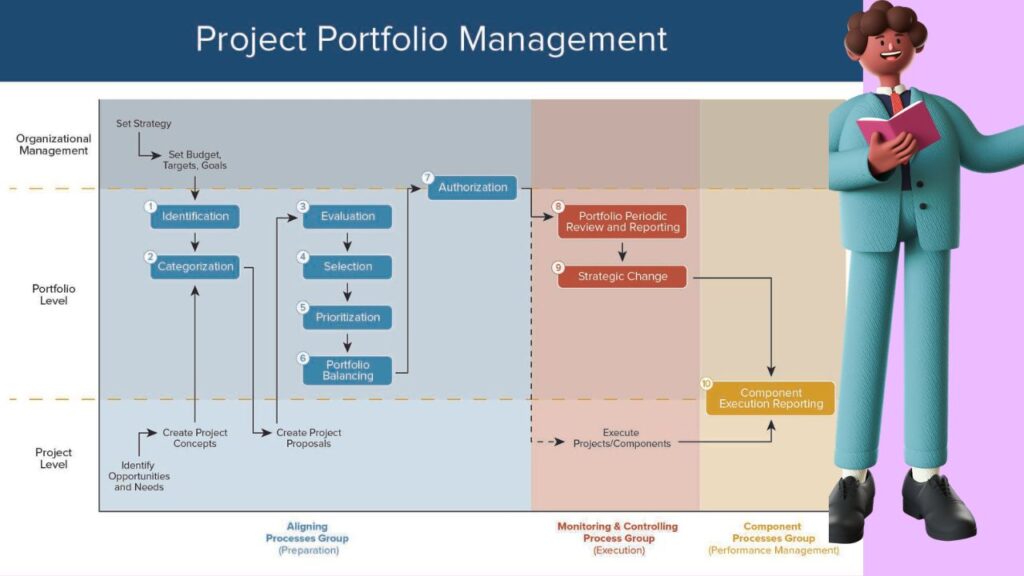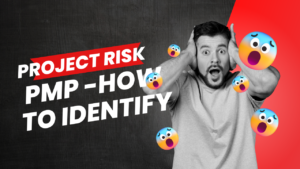I. Introduction
Program- In today’s complex business landscape, effective management is the bedrock of success. At the heart of this management ecosystem are three pivotal roles: Program Managers, Portfolio Managers, and Project Managers. While these titles might sound interchangeable, they each represent unique and indispensable facets of organizational leadership. In this comprehensive blog, we embark on a journey to dissect and demystify the distinctions between Program Managers and Project Managers. We’ll explore the nuanced responsibilities, the diverse skill sets required, and the critical roles they play within the context of modern industries.
A. Brief Overview of the Blog’s Purpose
This blog serves as a lighthouse in the sea of management roles, guiding professionals, aspiring leaders, and curious minds alike. Our mission is to shed light on the roles of Program Managers and Project Managers, unraveling their intricacies. By the end of this journey, you’ll not only comprehend the differences between these positions but also grasp their indispensable contributions to various industries. Whether you’re a seasoned executive, a budding project manager, or simply someone keen on understanding the dynamics of organizational management, this blog will empower you with knowledge that transcends the superficial labels.
B. Importance of Understanding the Differences
The confusion between Program Managers and Project Managers often stems from their seemingly interchangeable titles. Yet, these roles operate on distinct planes, each serving a unique purpose and catering to specific organizational needs. Understanding these differences is pivotal because it lays the foundation for efficient and effective management. It ensures that the right professionals are in the right roles, optimizing resource allocation, risk management, and strategic alignment. By the end of this blog, you’ll be equipped with the insights needed to make informed decisions about your career path, organizational structure, and project management strategies.
C. The Relevance of These Roles in Various Industries
In today’s dynamic business environment, adaptability and innovation are paramount. Program Managers and Project Managers are instrumental in driving these attributes across a spectrum of industries, from IT and finance to construction and healthcare. By appreciating their distinct roles and contributions, professionals can harness the power of effective management regardless of their field. We’ll showcase real-world examples and success stories to illustrate how these roles have reshaped industries and enabled organizations to thrive in the face of evolving challenges.
With a clear understanding of the roles, responsibilities, and impact of Program Managers and Project Managers, you’ll be better prepared to navigate the intricate web of modern management, elevate your career, and drive success in your organization.
Here’s a comparison table highlighting the key differences between Program Managers ,Project Managers and portfolio managers:
| Aspect | Program Manager | Project Manager | Portfolio Manager |
|---|---|---|---|
| Scope | Manages a portfolio of related projects | Manages a single project | Manages a portfolio of investments or assets |
| Responsibility | Ensures alignment with organizational goals and strategies | Focuses on achieving specific project objectives | Manages and maximizes returns on a portfolio of investments |
| Duration | Manages ongoing programs with no fixed end date | Manages projects with defined start and end dates | Monitors and adjusts the portfolio over time |
| Risk | Manages strategic risks that affect multiple projects | Manages project-specific risks | Manages investment risks and diversification |
| Stakeholder Engagement | Engages with high-level stakeholders, including executives | Collaborates with project-specific stakeholders | Communicates with investors, clients, and stakeholders |
| Resource Allocation | Allocates and reallocates resources across multiple projects in a portfolio | Allocates resources to a single project | Allocates and manages assets within a portfolio |
| Scope Change | Handles changes across the entire program or portfolio, considering their impact on multiple projects | Manages scope changes within the confines of a single project | Adjusts the portfolio based on changing market conditions |
| Success Metrics | Measures success based on organizational objectives, program benefits, and strategic alignment | Measures success based on project deliverables, timelines, and budgets | Measures success by portfolio performance and investment returns |
| Leadership | Requires strong strategic leadership and the ability to influence at an organizational level | Requires strong project leadership, including team management and decision-making | Requires financial expertise and investment strategy |
| Communication | Focuses on program-wide or portfolio-wide communication and alignment with executives and sponsors | Communicates primarily within the project team and stakeholders | Communicates with investors and provides regular portfolio updates |
| Decision-Making | Makes decisions with a strategic, long-term perspective | Makes decisions that impact the project’s immediate goals | Makes investment decisions to optimize portfolio performance |
| Complexity | Deals with high complexity due to the coordination of multiple projects and interdependencies | Handles complexity within the scope of a single project | Navigates financial markets, asset classes, and investment strategies |
| Examples | Oversees a company’s IT transformation program involving multiple projects in a portfolio | Manages the development and launch of a new software product | Manages a financial investment portfolio for clients or institutions |
II. Understanding Project Management
Project management is the backbone of transforming ideas into reality, ensuring tasks are completed efficiently, on time, and within budget. In this section, we’ll delve into the intricacies of project management, focusing on the vital role of Project Managers.
A. Definition and Role of a Project Manager
At its core, a Project Manager is the orchestrator of a project’s success. They are the captain of the ship, responsible for planning, executing, and closing projects. A Project Manager is the linchpin that holds together a team, ensuring that objectives are met and stakeholders are satisfied. Their role extends beyond task delegation; they are strategic thinkers who steer the project toward its goals. They act as communicators, problem-solvers, and leaders, bridging the gap between the client’s vision and the project’s execution.
B. Key Responsibilities of a Project Manager
The responsibilities of a Project Manager are multifaceted and include:
- Project Planning: Creating a comprehensive project plan, defining scope, timelines, and resources.
- Team Leadership: Building, motivating, and managing cross-functional teams.
- Risk Management: Identifying and mitigating risks that could derail the project.
- Communication: Maintaining clear and transparent communication with stakeholders.
- Quality Assurance: Ensuring project deliverables meet quality standards.
- Budget Control: Managing project finances and resource allocation.
- Scope Management: Controlling project scope to prevent “scope creep.”
- Problem Solving: Addressing issues as they arise and making decisions to keep the project on track.
C. Real-Life Examples of Project Management Scenarios
Project management is ubiquitous and transcends industries. Consider, for instance, the construction of a skyscraper in a bustling city. A Project Manager coordinates architects, engineers, construction workers, and subcontractors, ensuring that the project adheres to design specifications, safety regulations, and budget constraints. Similarly, in the realm of software development, a Project Manager oversees the creation of a new mobile app, juggling tasks like coding, design, testing, and user feedback to launch a polished product.
D. Challenges Faced by Project Managers
Project Managers face an array of challenges, from managing scope changes and resource constraints to dealing with unexpected roadblocks. The dynamic nature of projects means they must adapt swiftly to keep projects on course. Additionally, balancing competing priorities, communicating effectively with stakeholders, and maintaining team morale are constant challenges.
Understanding the pivotal role of Project Managers and the complexities they navigate is essential for anyone looking to thrive in project-driven industries or embark on a career in project management. It’s a role that combines leadership, strategic thinking, and adaptability, making it a cornerstone of successful project execution.
III. The Role of Program Managers
In the realm of organizational management, Program Managers are the architects of synergy, overseeing the coordination of multiple related projects to achieve strategic objectives. This section sheds light on the distinctive role and significance of Program Managers.
A. Definition and Purpose of a Program Manager
A Program Manager is a visionary leader entrusted with the responsibility of aligning an organization’s projects with its overarching goals and strategies. They act as strategic navigators, charting a course for the successful execution of interrelated projects that collectively contribute to a broader mission. Program Managers don’t just manage projects; they manage the big picture, ensuring that projects align with the organization’s strategic vision and deliver long-term value.
B. Key Responsibilities of a Program Manager
The responsibilities of a Program Manager encompass:
- Strategic Alignment: Ensuring that all projects within the program align with the organization’s strategic objectives.
- Resource Management: Optimizing resource allocation across multiple projects to maximize efficiency and effectiveness.
- Risk Management: Identifying and mitigating program-level risks that could impact multiple projects.
- Stakeholder Engagement: Facilitating communication and collaboration among project teams and stakeholders.
- Benefits Realization: Tracking and measuring the benefits derived from the program’s collective projects.
- Scope Management: Managing interdependencies and ensuring that projects don’t conflict or overlap.
- Strategic Decision-Making: Making high-level strategic decisions to keep the program on course.
C. How Program Managers Handle Multiple Related Projects
Program Managers possess the unique skill of managing complexity. They excel at identifying and managing interdependencies among projects, ensuring that the combined effort of these projects advances the organization’s strategic goals. They create a cohesive framework, defining how projects within the program interact, share resources, and contribute to the overall mission. This orchestration involves meticulous planning, ongoing monitoring, and proactive problem-solving to keep all projects aligned.
D. Benefits of Having Program Managers in Complex Organizations
Complex organizations, especially those with a multitude of interrelated projects, greatly benefit from Program Managers. These benefits include:
- Strategic Consistency: Program Managers ensure that projects collectively contribute to the organization’s strategic direction, reducing fragmented efforts.
- Resource Optimization: By efficiently allocating resources across projects, organizations save time and money.
- Risk Mitigation: Program Managers are adept at identifying and addressing program-level risks, preventing them from cascading into project failures.
- Improved Communication: Enhanced communication and collaboration among project teams and stakeholders lead to better decision-making and project outcomes.
- Benefits Realization: Organizations see a clearer path to realizing the intended benefits of their projects, leading to enhanced ROI.
Understanding the pivotal role of Program Managers in orchestrating the success of interrelated projects is crucial for professionals seeking to make a strategic impact within complex organizations. They are the architects of alignment, ensuring that the sum of an organization’s projects is greater than its individual parts.

IV. Navigating the Portfolio Manager Role
Portfolio Managers are the financial maestros of the business world, responsible for optimizing investments and assets to achieve financial goals. In this section, we unravel the role and significance of Portfolio Managers.
A. Definition and Significance of Portfolio Managers
Portfolio Managers are financial experts entrusted with the responsibility of managing a portfolio of investments or assets on behalf of clients, institutions, or organizations. Their significance lies in their ability to navigate financial markets, make informed investment decisions, and maximize returns while mitigating risks. Portfolio Managers play a pivotal role in helping clients grow their wealth and achieve their financial objectives.
B. Key Responsibilities of Portfolio Managers
The key responsibilities of Portfolio Managers include:
- Asset Allocation: Strategically distributing investments across different asset classes (e.g., stocks, bonds, real estate) to optimize returns and manage risk.
- Investment Selection: Identifying and selecting individual investments or securities that align with the portfolio’s objectives.
- Risk Assessment and Management: Evaluating the risk associated with each investment and implementing strategies to mitigate risk.
- Performance Monitoring: Continuously monitoring the portfolio’s performance and making adjustments as necessary.
- Client Communication: Maintaining clear and transparent communication with clients, providing updates on portfolio performance and market conditions.
- Regulatory Compliance: Ensuring that all investments and portfolio management activities comply with relevant financial regulations.
- Financial Analysis: Conducting in-depth financial analysis and research to inform investment decisions.
C. Managing Investments and Assets within a Portfolio
Portfolio Managers possess a deep understanding of financial markets and investment vehicles. They make decisions on which assets to buy, hold, or sell within the portfolio to achieve specific financial objectives. This involves analyzing market trends, assessing the risk-return trade-offs of different investments, and adjusting the portfolio’s composition accordingly. The aim is to create a diversified portfolio that spreads risk while optimizing returns.
D. Portfolio Diversification and Risk Management
Diversification is a cornerstone of Portfolio Managers’ strategy. They strategically spread investments across a variety of asset classes, industries, and geographic regions to reduce the impact of any single investment’s poor performance. Additionally, Portfolio Managers are skilled in risk management, employing techniques such as hedging and asset allocation to safeguard investments from market volatility.
The role of Portfolio Managers is essential in today’s financial landscape, where individuals, organizations, and institutions seek to grow their wealth and secure their financial future. Their ability to navigate financial markets, manage risks, and make informed investment decisions is paramount to achieving financial success and ensuring a secure financial future.
V. Side-by-Side Comparison
To gain a comprehensive understanding of the distinctions between Program Managers, Portfolio Managers, and Project Managers, let’s examine these roles through a detailed comparison, visual aids, and how they harmonize within organizations.
A. Detailed Comparison Table
Let’s create a comprehensive table that highlights the differences in scope, responsibilities, and more among Program Managers, Portfolio Managers, and Project Managers. This table will serve as a quick reference guide for readers, summarizing the unique attributes of each role.
Here’s a sample of what the table might look like:
| Aspect | Program Manager | Portfolio Manager | Project Manager |
|---|---|---|---|
| Scope | Manages a program of related projects | Manages a portfolio of investments/assets | Manages a single project |
| Responsibilities | Aligns projects with organizational goals | Optimizes investments for returns | Plans and executes projects |
| Duration | Manages ongoing program with no fixed end date | Ongoing management of investments | Manages projects with fixed timelines |
| Risk Management | Manages program-level risks | Manages investment risks | Manages project-specific risks |
| Stakeholder Engagement | Engages with high-level stakeholders | Communicates with clients and stakeholders | Collaborates with project-specific stakeholders |
| Resource Allocation | Allocates resources across multiple projects | Allocates financial assets | Allocates resources to a single project |
| Scope Change Management | Manages changes across the entire program | Adjusts portfolio based on market conditions | Manages scope changes within a project |
| Success Metrics | Measures success based on program benefits | Measures success by portfolio performance | Measures success based on project deliverables |
| Leadership | Provides strategic leadership | Offers financial expertise | Offers project leadership |
| Communication | Focuses on program-wide communication | Communicates with clients and stakeholders | Communicates within the project team |
| Decision-Making | Makes strategic decisions for the program | Makes investment decisions | Makes project-related decisions |
| Complexity | Deals with high complexity due to project interdependencies | Navigates financial markets | Handles complexity within a project |
| Examples | Oversees a company’s IT transformation program | Manages a financial investment portfolio | Manages a product launch project |
B. Visual Aids
To further enhance understanding, we can incorporate visual aids such as diagrams, charts, or infographics that illustrate the differences among these roles. Visual representations can simplify complex concepts and make the distinctions more accessible to readers.
C. How These Roles Complement Each Other Within Organizations
Highlight how Program Managers, Portfolio Managers, and Project Managers work in concert within organizations. While they have distinct roles, they often collaborate to ensure that strategic goals are met. Program Managers set the strategic direction, Portfolio Managers manage financial resources to support the strategy, and Project Managers execute individual projects that contribute to the larger objectives. Illustrate how this synergy benefits organizations by optimizing resources, managing risk, and aligning projects with strategic goals.
By providing a side-by-side comparison, visual aids, and insights into their collaborative nature, readers will gain a comprehensive understanding of how these managerial roles operate and interact within the organizational ecosystem.
VI. Industries and Scenarios
Understanding how Program Managers, Portfolio Managers, and Project Managers operate in various industries and scenarios is key to appreciating their versatility and value. In this section, we explore their applications, highlight their unique contributions, and showcase real-world success stories.
A. Application of These Roles in Various Industries
- IT Industry: In IT, Program Managers oversee large-scale digital transformations that involve multiple interrelated projects, ensuring seamless integration and alignment with business goals. Portfolio Managers manage IT investments to optimize returns, while Project Managers execute software development projects.
- Finance Sector: Portfolio Managers in finance manage investment portfolios for clients or institutions, making strategic asset allocation decisions. Program Managers may oversee the implementation of financial software systems, and Project Managers handle projects such as launching new financial products.
- Construction: In the construction industry, Program Managers manage programs involving multiple construction projects, ensuring compliance with safety regulations and quality standards. Portfolio Managers may handle real estate investment portfolios, and Project Managers oversee individual construction projects.
B. Scenarios Where Each Role Shines
- Program Manager: Shine in scenarios where an organization embarks on a strategic initiative involving numerous projects. For example, a Program Manager is crucial when a healthcare provider aims to enhance patient care by implementing electronic health records across multiple hospitals.
- Portfolio Manager: Excel in scenarios where wealth management and investment optimization are paramount. A Portfolio Manager shines when a high-net-worth individual seeks to diversify their investment portfolio to achieve long-term financial goals.
- Project Manager: Thrive in scenarios requiring focused project execution. For instance, when a manufacturing company decides to introduce a new production line, a Project Manager ensures the project stays on schedule, within budget, and meets quality standards.
C. Success Stories of Professionals in These Roles
- Program Manager Success Story: Jane, a Program Manager at a tech giant, led a program to develop a suite of new products. Her strategic oversight and alignment with the company’s vision resulted in a successful product launch, generating millions in revenue.
- Portfolio Manager Success Story: Alex, a Portfolio Manager at a financial firm, skillfully managed a diverse portfolio of assets during a volatile market period. His astute asset allocation decisions not only protected clients’ investments but also delivered impressive returns.
- Project Manager Success Story: David, a Project Manager in the construction industry, oversaw the construction of a complex bridge. Despite unexpected weather challenges, his adept project management ensured the bridge was completed on time, enhancing the region’s transportation infrastructure.
By showcasing the applications of these roles in different industries, scenarios where their expertise shines, and real-life success stories, readers gain insights into how Program Managers, Portfolio Managers, and Project Managers make a tangible impact across diverse fields and challenges.
VII. Qualifications and Career Paths
Understanding the qualifications and career paths for Program Managers, Portfolio Managers, and Project Managers is vital for those considering these roles. In this section, we’ll explore the educational and professional requirements, career progression, and offer valuable tips for aspiring professionals.
A. Educational and Professional Qualifications for Each Role
- Program Manager:
- Educational Qualifications: A bachelor’s degree in a related field is often a minimum requirement. Many Program Managers hold advanced degrees (e.g., MBA) for a competitive edge.
- Professional Qualifications: Certifications such as PMP (Project Management Professional), PgMP (Program Management Professional), or PfMP (Portfolio Management Professional) can enhance qualifications.
- Portfolio Manager:
- Educational Qualifications: A bachelor’s degree in finance, economics, or a related field is common. Advanced degrees like a master’s in finance or a CFA (Chartered Financial Analyst) designation are highly regarded.
- Professional Qualifications: Certifications like CFA, CIPM (Certificate in Investment Performance Measurement), or FRM (Financial Risk Manager) can elevate a Portfolio Manager’s credentials.
- Project Manager:
- Educational Qualifications: A bachelor’s degree in any field is suitable, although degrees in project management or related disciplines are beneficial. Advanced degrees or PMP certification can enhance qualifications.
- Professional Qualifications: PMP certification is widely recognized and valuable for Project Managers.
B. Career Progression and Growth Opportunities
- Program Manager:
- Career Progression: Program Managers often progress to executive or senior leadership roles, such as Chief Operating Officer (COO) or Chief Strategy Officer (CSO).
- Growth Opportunities: As organizations continue to undertake complex strategic initiatives, the demand for skilled Program Managers remains high, offering ample growth opportunities.
- Portfolio Manager:
- Career Progression: Experienced Portfolio Managers can advance to roles like Chief Investment Officer (CIO) or Investment Director.
- Growth Opportunities: Portfolio Managers often have the opportunity to manage larger portfolios and take on more significant responsibilities as they gain experience.
- Project Manager:
- Career Progression: Project Managers can advance to roles such as Senior Project Manager, Program Manager, or Director of Project Management.
- Growth Opportunities: The demand for skilled Project Managers is consistent across industries, offering numerous opportunities for career advancement.
C. Tips for Aspiring Program, Portfolio, and Project Managers
- Continuous Learning: Stay updated with industry trends and best practices by attending seminars, workshops, and pursuing relevant certifications.
- Effective Communication: Develop strong communication skills to convey ideas, manage stakeholders, and foster collaboration.
- Leadership Skills: Hone leadership qualities to inspire and motivate teams to achieve project or organizational goals.
- Adaptability: Embrace change and develop adaptability, as the business landscape is constantly evolving.
- Networking: Build a professional network to gain insights, mentorship, and career opportunities.
- Project Experience: Gain practical project experience through internships or entry-level positions to kickstart your career.
- Portfolio Management: For Portfolio Managers, focus on mastering financial analysis, risk management, and asset allocation strategies.
- Strategic Thinking: Program Managers should develop strategic thinking skills to align programs with organizational objectives.
- Project Management Tools: Familiarize yourself with project management tools and software commonly used in the industry.
By following these tips and investing in education, certification, and skill development, aspiring Program, Portfolio, and Project Managers can pave the way for a successful and fulfilling career in these dynamic roles.
VIII. Challenges and Rewards
Understanding the challenges and rewards associated with roles like Program Managers, Portfolio Managers, and Project Managers is crucial for professionals considering these career paths. In this section, we’ll explore the common challenges faced by these professionals, the rewarding aspects of their careers, and how organizations benefit from well-defined managerial roles.
A. Common Challenges Faced by Professionals in These Roles
- Program Manager:
- Managing Complexity: Balancing multiple interdependent projects and navigating complexities can be challenging.
- Alignment: Ensuring alignment between program objectives and organizational goals can be a constant challenge.
- Portfolio Manager:
- Market Volatility: Portfolio Managers must navigate unpredictable financial markets, making informed investment decisions in dynamic conditions.
- Risk Management: Managing investment risks and ensuring portfolio stability is a continuous challenge.
- Project Manager:
- Scope Creep: Managing scope changes while keeping projects on track can be a major challenge.
- Resource Constraints: Ensuring that projects are executed efficiently within budget constraints can pose difficulties.
B. Rewards, Both Intrinsic and Extrinsic, of a Career in Management
- Program Manager:
- Strategic Impact: Program Managers enjoy the satisfaction of driving strategic initiatives that shape an organization’s future.
- Career Growth: The role often leads to executive positions and offers excellent career growth opportunities.
- Portfolio Manager:
- Financial Success: Portfolio Managers are often well-compensated, with the potential for substantial financial rewards.
- Intellectual Stimulation: Making complex investment decisions and achieving solid returns can be intellectually fulfilling.
- Project Manager:
- Project Completion: The satisfaction of successfully completing projects and delivering tangible results is a significant reward.
- Leadership Development: Project Managers develop strong leadership skills that can be applied in various contexts.
C. How Organizations Benefit from Well-Defined Managerial Roles
- Efficient Resource Utilization: Well-defined roles ensure that resources (human, financial, and time) are efficiently allocated to projects, programs, and portfolios, maximizing ROI.
- Strategic Alignment: Managerial roles align projects, programs, and portfolios with the organization’s strategic goals, fostering coherence and direction.
- Risk Mitigation: Clear roles enable effective risk management at various levels, reducing the likelihood of project, program, or portfolio failures.
- Stakeholder Satisfaction: Organized management roles enhance communication with stakeholders, ensuring their expectations are met or exceeded.
- Innovation and Growth: These roles drive innovation, growth, and adaptability, enabling organizations to thrive in dynamic environments.
- Talent Development: Well-defined roles provide career paths and opportunities for professionals to develop and advance within the organization.
- Competitive Advantage: Effective management roles contribute to a competitive advantage by streamlining processes and ensuring optimal project, program, and portfolio outcomes.
Understanding the challenges, rewards, and organizational benefits associated with these managerial roles helps both professionals and organizations appreciate the value they bring to the table. It underscores the importance of investing in talent development and ensuring that managerial roles are well-defined and effectively executed.

IX. Case Studies
Real-world case studies provide concrete examples of how Program Managers, Portfolio Managers, and Project Managers make a significant impact on organizations. These studies highlight their contributions and demonstrate their value.
A. Real-World Case Studies Highlighting Successful Managers
- Program Manager: Sarah led a program for a multinational corporation to streamline its supply chain operations. Her strategic oversight and meticulous planning resulted in a 20% reduction in operational costs and a 30% increase in supply chain efficiency.
- Portfolio Manager: John managed a diverse investment portfolio for a high-net-worth client. Through astute asset allocation and risk management, he achieved a 15% return on investment in a volatile market, securing the client’s financial future.
- Project Manager: Emily was the Project Manager for a healthcare organization’s electronic health records implementation. Her leadership ensured a seamless transition, improving patient care and reducing administrative errors by 40%.
B. The Impact of Their Contributions on Organizations
- Program Managers align organizational initiatives with strategic goals, enabling companies to achieve long-term objectives and adapt to changing market conditions.
- Portfolio Managers optimize investments, safeguarding financial assets, and delivering impressive returns, which contributes to an organization’s financial stability and growth.
- Project Managers drive the successful execution of projects, resulting in tangible benefits such as cost savings, improved efficiency, and enhanced customer satisfaction.
X. Conclusion
A. Summarizing the Key Differences
In conclusion, Program Managers, Portfolio Managers, and Project Managers are distinct roles within the management ecosystem, each contributing uniquely to the success of organizations:
- Program Managers provide strategic direction and oversee multiple interrelated projects.
- Portfolio Managers optimize financial resources and investments to achieve financial goals.
- Project Managers execute individual projects, delivering tangible results on time and within budget.
B. Emphasizing the Importance
The importance of these roles cannot be overstated in modern businesses. They are the architects of strategic alignment, financial stability, and project execution. Their expertise ensures organizations remain competitive, adaptable, and efficient in an ever-evolving business landscape.
C. Encouraging Readers to Explore and Pursue Careers in Management
This exploration of Program Managers, Portfolio Managers, and Project Managers should inspire readers to consider these dynamic roles in their career journeys. Whether you aspire to strategize, manage finances, or lead projects, the world of management offers diverse and fulfilling opportunities for professional growth and impact.
In embracing these roles, professionals contribute to organizational success, foster innovation, and drive growth. They become the navigators of change, the stewards of investments, and the champions of efficient execution, shaping the future of businesses across industries.



